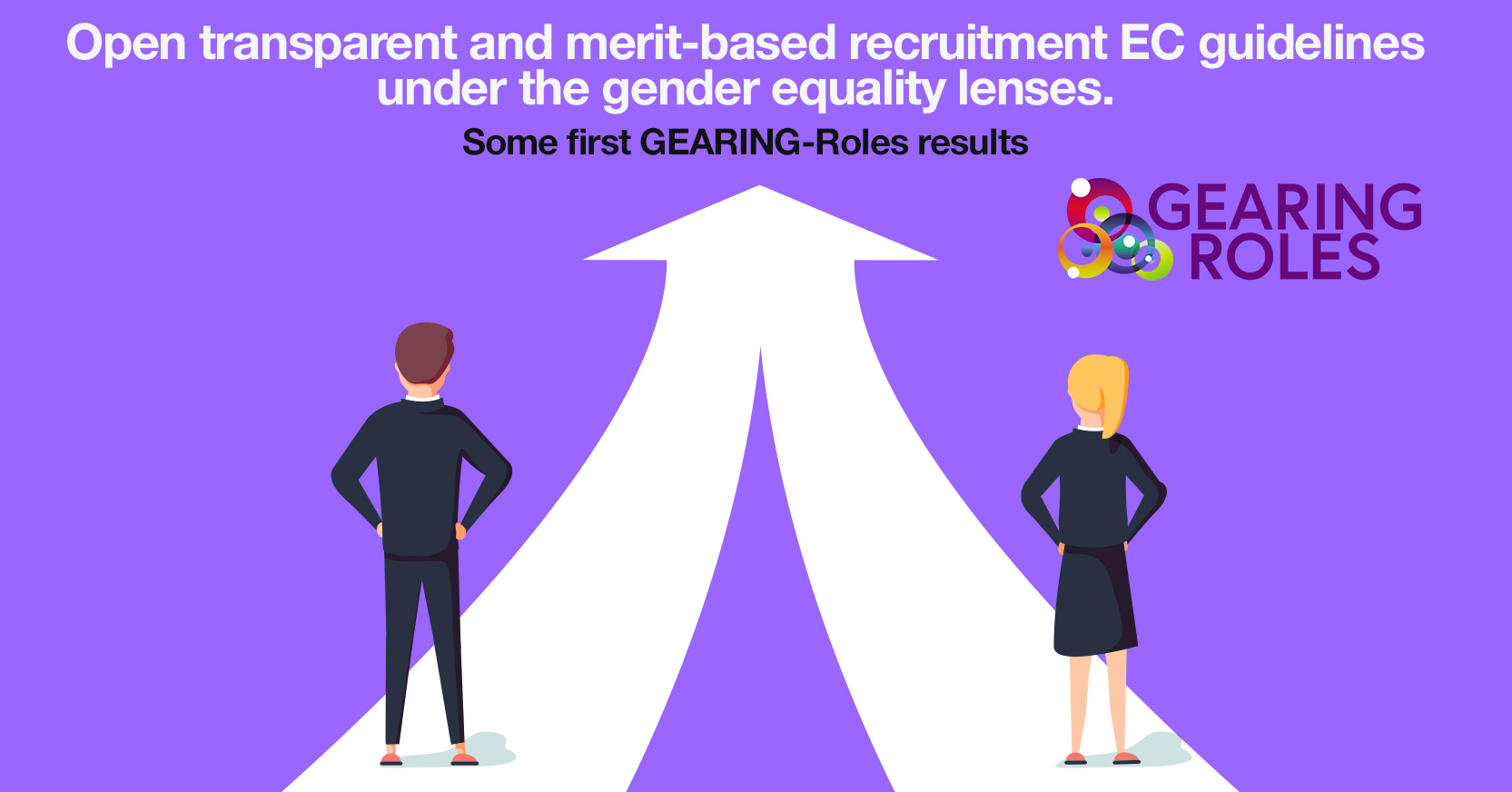
11 Mar Open transparent and merit-based recruitment European Commission guidelines under the Gender Equality lenses. Some first GEARING-Roles results
One of the priorities of the European Research Area is to achieve an “open labour market for researchers in Europe”. For that to happen, it is important that European research performing organizations and European researchers share common rights and obligations. In order to foster this goal, the European Commission adopted the “European Charter for Researchers and a Code of Conduct for the Recruitment of Researchers”, which identifies the 40 principles that should be the backbone of a shared European researcher identity.
For the Charter and Code to be rolled out throughout Europe, the European Commission recognizes with the ‘HR Excellence in Research Award’ the institutions which make progress in aligning their human resources policies to the 40 principles of the Charter & Code, based on a customized action plan/HR strategy. More than 507 organizations have received this recognition already.
One of the key elements of the Charter and Code and the HRS4R is of course contribute to develop common open, transparent, merit based recruitment for researchers in Europe. In order to facilitate the self-assessment of institutions towards this key topic, the strategy has the so called “OTM-R checklist”, which includes a detailed list of criteria any institution should cover when evaluating their recruitment policies and, in particular, their advertising, selection and evaluation, and appointment phases.
The overall process of aligning HHRR institutional policies to the Charter Code has a number of parallelisms with the implementation of Gender Equality Plans and there should be ways in which both activities take advantage of synergies. The OTM-R checklist in particular can be used to foster recruitment practices that favour gender equality, and as a matter of fact, the current version of the checklist already addresses the issue through some items such as the existence of gender equality in the selection committees. Nevertheless, the persistence of gender biases in recruitment procedures in general (not only in research), as observed in the recent report She Figures 2018, which confirmed that more than one third of Europeans believe that men are more ambitious than women (35%), or that almost seven in ten respondents think women are more likely than men to make decisions based on their emotions (69 %).
This situation has prompted GEARING-Roles to revisit the OTM-R checklist to assess which parts of the document could be strengthened from a gender perspective to further avoid gender biases in the recruitment of researchers.
One of the objectives of Gearing Roles is to analyse the current Open, Transparent and Merit based recruitment checklist to provide with recommendations on how those could incorporate specific gender-equality measures
In June 2019, GEARING-Roles organized a first webinar addressing recruitment and career development good practices fostering gender equality in Higher Education Institutions with contributions from the University of Vigo (Spain), the University of Zurich (Switzerland) and the Norwegian Technical University (Norway); and the participation of 39 people coming from the GEARING Roles consortium, sister projects and EURAXESS network. During the webinar, a survey to collect input on possible ways to strengthen the gender dimension of the recruitment process was distributed among participants.
Later on November 27th 2019, the first training on the OTM-R checklist was hosted by FECYT for the rest of the GEARING Roles partners. In this case the collection of feedback was completely focused on the recruitment processes. Partners were introduced to the HRS4R, highlighting its connections with the Charter & Code and EURAXESS, to later devote time to analyse the content of the checklist.
Together, these two activities allowed compiling ideas that could somehow contribute to reinforcing the different parts of the OTM-R checklist that could foster gender equality, such as:
Recruitment system as whole:
- Keeping sex-disaggregated data on all parts of the process (applications, shortlisting and appointed).
- Implement mechanisms to support disadvantaged candidates.
- Clear guidelines and transparency about the overall recruitment process for all potential candidates.
- Institutional legal commitment to non-biased recruitment and systems to ensure application (e.g., audits, written commitment of panel members, etc.).
Advertising and application phase:
- Clear criteria to be assessed during the selection and evaluation phase.
- Ensure gender sensitive language is used, taking into account gendered concepts such as “excellence”.
- Highlight the existence of institutional policies against sexism, sexual harassment and gender-based violence.
- Include references to any equity measures already in place (e.g., dual career services, work-life balance policies, child-care facilities, mentoring, etc.).
- Include relevant information on career progression.
Selection and evaluation phase:
- Diversity in the composition of selection committees, not only respecting gender balance but also intersectionality.
- Systematic trainings on gender equality and unconscious biases for selections committee members, and institutional recognition of participating in such trainings.
- Meeting and greeting protocols for the selection committee members.
- Consistent questions for all candidates, addressing only relevant criteria.
- Applying pre-defined role plays to committee members.
- External selection committee members (e.g., from other disciplines, institutions and/or countries) and observers (e.g., a representative from gender unit).
- The implementation of measures to facilitate blind evaluations (e.g., blind CVs, blind interviews using technological resources, etc.).
- Support measures to facilitate candidates to participate in the selection and evaluation procedure (family friendly scheduling of interviews, flexibility, support for care obligations, etc.).
The appointment phase:
- Appointing all underrepresented groups candidates that meet the required threshold.
- Providing constructive feedback to all candidates, regardless of being selected or not.
- Establishing anonymous feedback mechanisms about the application process for all candidates.
It is important to highlight that the spirit of the OTM-R checklist is facilitating institutions to assess their recruitment policies, at the same time as it provides recommendations on how to improve them in order to become more open, transparent and merit-based. Keeping in mind this idea, a first attempt of reviewed OTM-R checklist is presented here including many of the abovementioned ideas as suggested principles, subprinciples, indicators and good practices, all aimed at fostering gender equality at the level of institutional recruitment policies.
FIRST RESULTS OF THE GEARING ROLES CO-CREATION PROCESS. THE OPEN, TRANSPARENT, MERIT BASED RECRUITMENT CHECKLIST SEEN WITH GENDER EQUALITY LENSES.
The table below tries to summarize all the input gathered in the GEARING-Roles workshops where gender equality experts analysed the current OTMR-Checklist and discussed actions which could lead to strengthening the gender equality measures of the recruitment process. Depending on the kind of action, these have been included into the checklist in the shape of new principles, subprinciples and indicators, as well as some clarifications about the gender-equality implications of the proposals made.
You can see the table here.
NEXT STEPS
The OTM-R checklist is a tool designed to foster good practices in the recruitment of researchers. Due to the fact that the tool is part of the HRS4R, the document has been primarily developed from the point of view human resources management.
The review of the tool presented here is a group reflection of several gender equality experts engaged in the preparation of institutional gender equality plans for several Higher Education Institutions. A future consultation with stakeholders linked to human resources management in research (e.g., through the EURAXESS network) is envisaged to complement this exercise.
Furthermore, the OTM-R Checklist also includes a number of good practices and provides examples of how its principles are implemented in different organization. In line with this idea, throughout the consultation exercise, additional existing good practices are being compiled. These will be included as part of the recommendation on how to evolve the OTM-R checklist for better gender equality.



No Comments